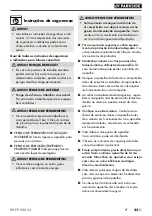
PDFP 500 C3
GB
│
MT
│
37
■
■
After every use, squirt thinners (
only outside –
risk of explosion!
) or water through the appli-
ance.
♦
To clean the housing, the nozzle head and
the spray holes inside it, use the supplied
cleaning brush or a cloth. Never use petrol,
solvents or cleansers which can damage plastic.
♦
First, unscrew the stroke limiter screw by
turning it in an anticlockwise
direction.
♦
Remove the spring .
♦
Remove the needle using pliers (see fig. A).
♦
Clean the needle carefully with the brush
(see fig. B).
♦
Replace the needle in the paint spray gun.
♦
Push the spring onto the end of the
needle .
♦
Screw the stroke limiter screw tight by turning
it clockwise
.
♦
Screw the flow cup anticlockwise
off the
spray gun.
♦
Remove the filter as shown in fig. C and
clean it with the cleaning brush.
♦
Also clean the screw thread of the flow
cup using the cleaning brush (see fig. D).
♦
Replay the filter in the spray gun (see fig. C)
and screw the flow cup clockwise
firmly
onto it.
♦
For rust protection purposes, you can spray a
little sewing machine oil through the spray gun
after cleaning.
♦
Oil all moving parts from time to time.
♦
After cleaning the needle, the thread and seal
must be lightly greased with a suitable lubricant.
♦
Do not use any silicon-based lubricants.
♦
Store compressed-air appliances only in dry
rooms.
Disposal
The packaging consists of environ-
mentally friendly material. It can be
disposed of in the local recycling
containers.
Your local community or municipal authorities can
provide information on how to dispose of the
worn-out appliance.
Dispose of the packaging in an
environmentally friendly manner.
Note the labelling on the packaging
and separate the packaging material
components for disposal if necessary. The pack-
aging material is labelled with abbreviations (a)
and numbers (b) with the following meanings:
1–7: Plastics, 20–22: Paper and cardboard,
80–98: Composites.
Your local community or municipal
authorities can provide information on
how to dispose of the worn-out
product.
Environmental compatibility and material
disposal
■
Paints and lacquers… are considered special
waste which must be disposed of accordingly.
■
Observe the local regulations.
■
Observe the manufacturer’s instructions.
■
Environmentally harmful chemicals must not be
allowed to get into the ground, groundwater or
any body of water.
■
Spraying work next to bodies of water or
adjoining surfaces thereof (catchment basin) is
therefore not permitted.
■
When buying paints, lacquers… pay attention
to their environmental compatibility.
Summary of Contents for 339135 1910
Page 3: ...A B C D...















































